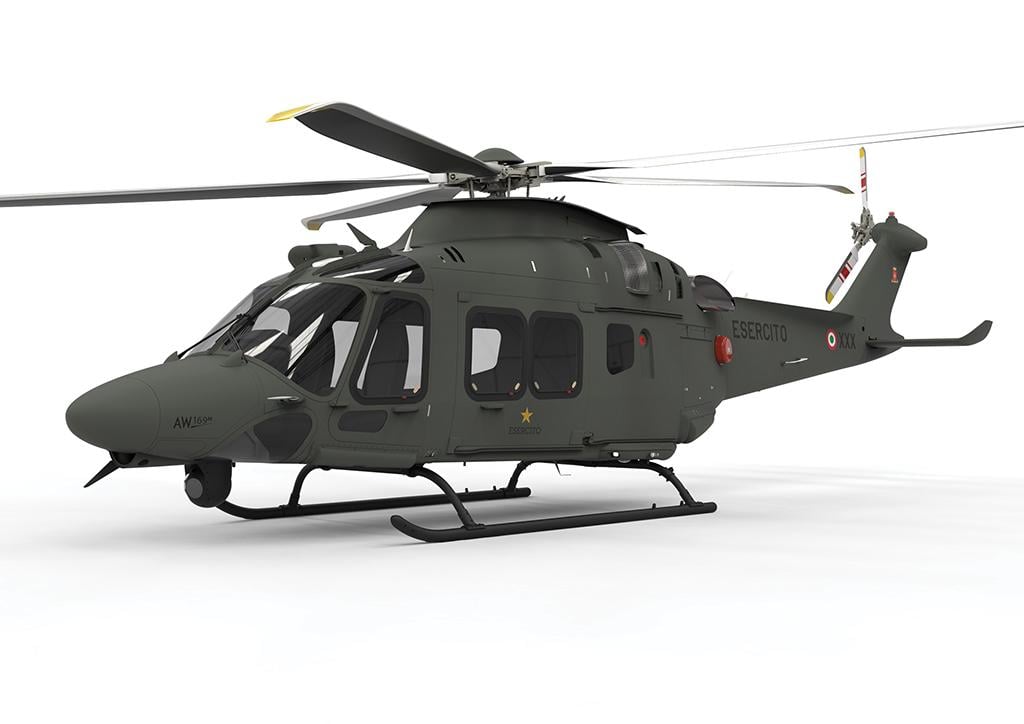
Leonardo is beefing up the capabilities of its AW169 twin-engine rotorcraft as it prepares it for a military career.
With deliveries of about 130 of the 4.8-metric-ton helicopter, the type is already enjoying commercial success in the VIP, emergency medical service, law enforcement and even offshore windfarm support missions. But the OEM is now finalizing certification of the first major enhancements to the platform since its introduction in 2015.
- Italy planning for AW169M to be backbone of Army, Carabinieri helicopter fleets
- AW169’s skidded landing gear to be certified in mid-2022
The changes, to be certified by year-end, are focused on the AW169’s engine, dynamic systems and aerodynamics, boosting its capabilities in hot-and-high conditions.
The Enhanced Performance Pack (EPP) makes software changes to the Pratt & Whitney PW210A engine full-authority digital engine control system to squeeze an additional 45 shp out of each powerplant without affecting the time between overhauls, currently at 4,000 hr. Meanwhile, collection of data about the usage of the main gearbox has enabled a 150-shp increase in the rating of the transmission.
The company has also made a series of distinctive aerodynamic changes to the aircraft, particularly around the tail boom and anti-torque system. Engineers have done away with the standard horizontal stabilizer and its upturned tips, introducing an end plate that twists back toward the tail boom at an angle. The OEM says the changes provide an additional surface area that enhances the aircraft’s behavior at high speeds.
An optional superior performance pack delivers an additional 22 shp from each of the engines, on top of that provided for the EPP.
Leonardo has combined all the changes, along with appropriate adjustments to the avionics suite, “to take full advantage of the power increase,” Nicolo Sanguineti, Leonardo Helicopters’ head of product marketing and sales engineering, tells Aviation Week. The configuration will now be the baseline for all new-build AW169s but will also be retrofittable to those already in service. The company is planning to put out a service bulletin, with the retrofit expected to take the aircraft out of service for several days.
“This will enhance the mission capability enabling the carriage of extra payload,” Sanguineti says.
The EPP changes are in addition to work Leonardo is doing to widen the configurations available. When the aircraft was initially developed, it was equipped with a retractable wheeled landing gear, but the offering has now broadened to include fixed wheeled gear and—most crucially—skids, to be certified in mid-2022.
Both the skid gear and the EPP will be key components of the military AW169M now in advanced development for the Italian Armed Forces and some of the nation’s government agencies.
Rome is eyeing purchases of the AW169M to replace swathes of locally produced Agusta-Bell products that still dominate the inventory of Italian Army Aviation, including AB206 JetRangers, AB205 Iroquois/Hueys, AB212 Twin-Hueys and AB412 Griffons. The AW169M is also due to be adopted by the country’s military police, the Carabinieri, while its financial police, the Guardia di Finanza, have already taken several AW169s on charge—-18 of its 22 planned aircraft will be in the skid-gear configuration.
The Italian Army’s AW169Ms will be equipped with an advanced command, control and communication system and fitted with the OEM’s Multiple Aperture InfraRed (MAIR) distributed aperture threat warning system, which can detect incoming missiles and hostile gunfire in the baseline configuration. Its armament will initially be limited to crew-served door guns, but Leonardo is examining the potential of equipping the aircraft with gun and rocket pods, in line with similar work on its AW149 platform.

Two commercial-model AW169s were handed over to the Italian Army last year to support training in preparation for the introduction of the AW169M.
Italy’s plans mirror those of France, which will purchase the Airbus H160M twin-engine medium rotorcraft as its new Joint Light Helicopter to replace Alouette III, Gazelle, Dauphin, Fennec and Panther fleets in the French Army, Navy and Air Force.
Exports for the military AW169M are also in the cards. The platform has been selected by Austria, which plans to buy 18 to replace its Alouette IIIs. Contract negotiations are continuing, but Leonardo projects that the platform could replace hundreds of Bell 205/212/412-class aircraft still operating around the world.
Meanwhile, Leonardo is also progressing work on a Full Ice Protection System (FIPS) for the platform. Because of their weight and power consumption, FIPS are normally fitted to medium and large helicopters. Its development for a smaller type was done in response to Swiss Air Rescue--Rega, an emergency medical service operator seeking a helicopter that could operate in any weather encountered in the Swiss Alpine region (AW&ST Feb. 29-March 13, 2016, p. 64)
Development of the AW169 FIPS, which features deicing boots on the main rotor blades, anti-icing tail rotor blades and heated cockpit windows, has taken longer than planned, due to delays caused by the COVID-19 pandemic that prevented the aircraft from being sent to the U.S. for testing. An icing flight-test campaign is slated to begin in November, and the OEM is targeting certification in 2023.
Editor's note: This article was updated to correct the AW169's weight and the number of commercial-model helicopters handed over to the Italian Army last year.





